The document discusses various linear data structures like arrays, strings, stacks, queues, and linked lists. It provides details on representing single and multi-dimensional arrays, including addressing formulas. Operations on ordered lists like lists are defined. Linear lists using arrays are implemented with methods for adding, removing, and changing elements.
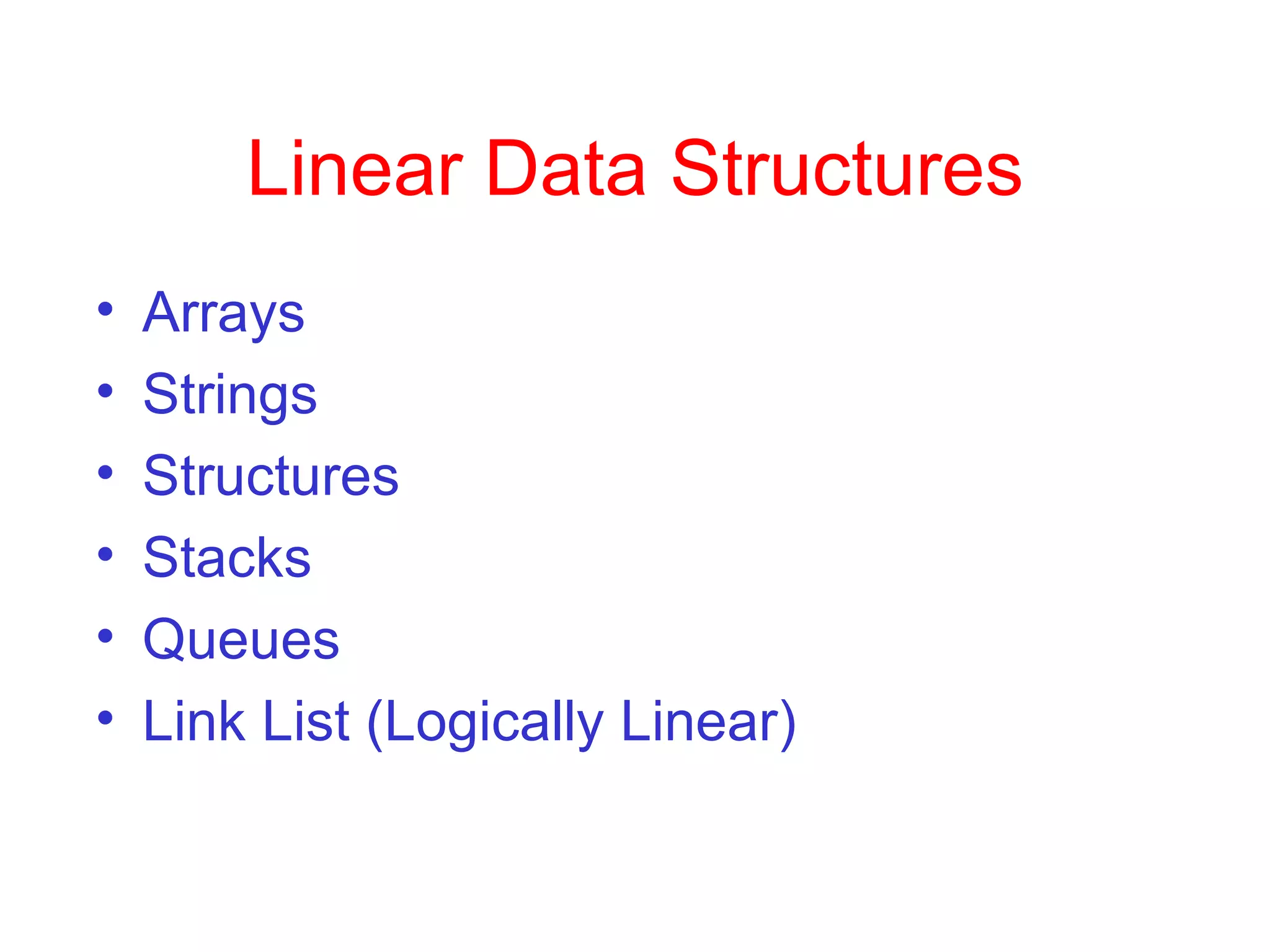
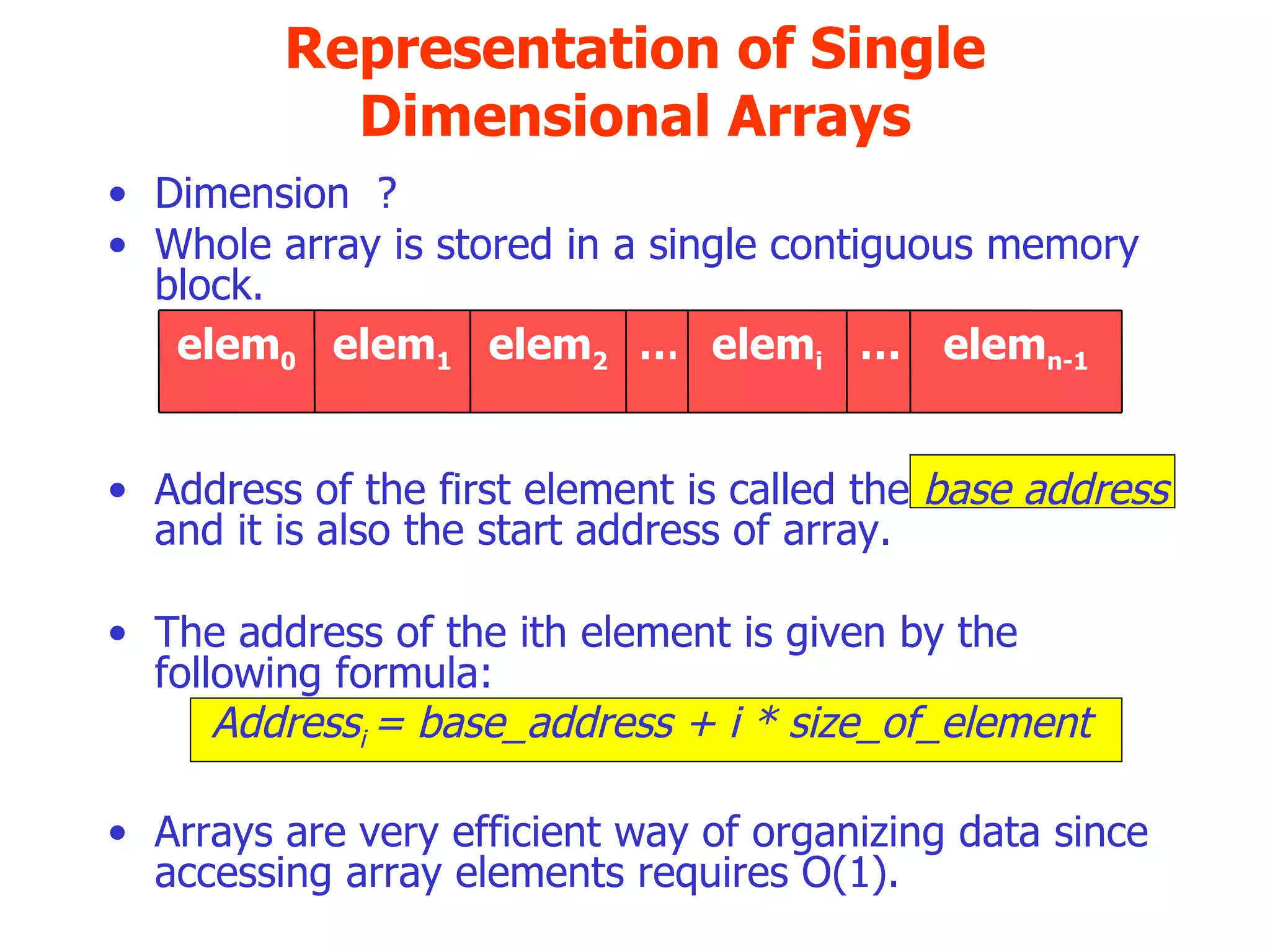
![float sum (float *list, int n) { float temp = 0; int i; for (i = 0; i < n; i++) temp = temp + *(list + i); return temp; } float sum (float list[], int n) { float temp = 0; int i; for (i = 0; i < n; i++) temp = temp + list[i]); return temp; }](https://image.slidesharecdn.com/02arraysandmemorymapping-090910110832-phpapp01/75/02-Arrays-And-Memory-Mapping-3-2048.jpg)
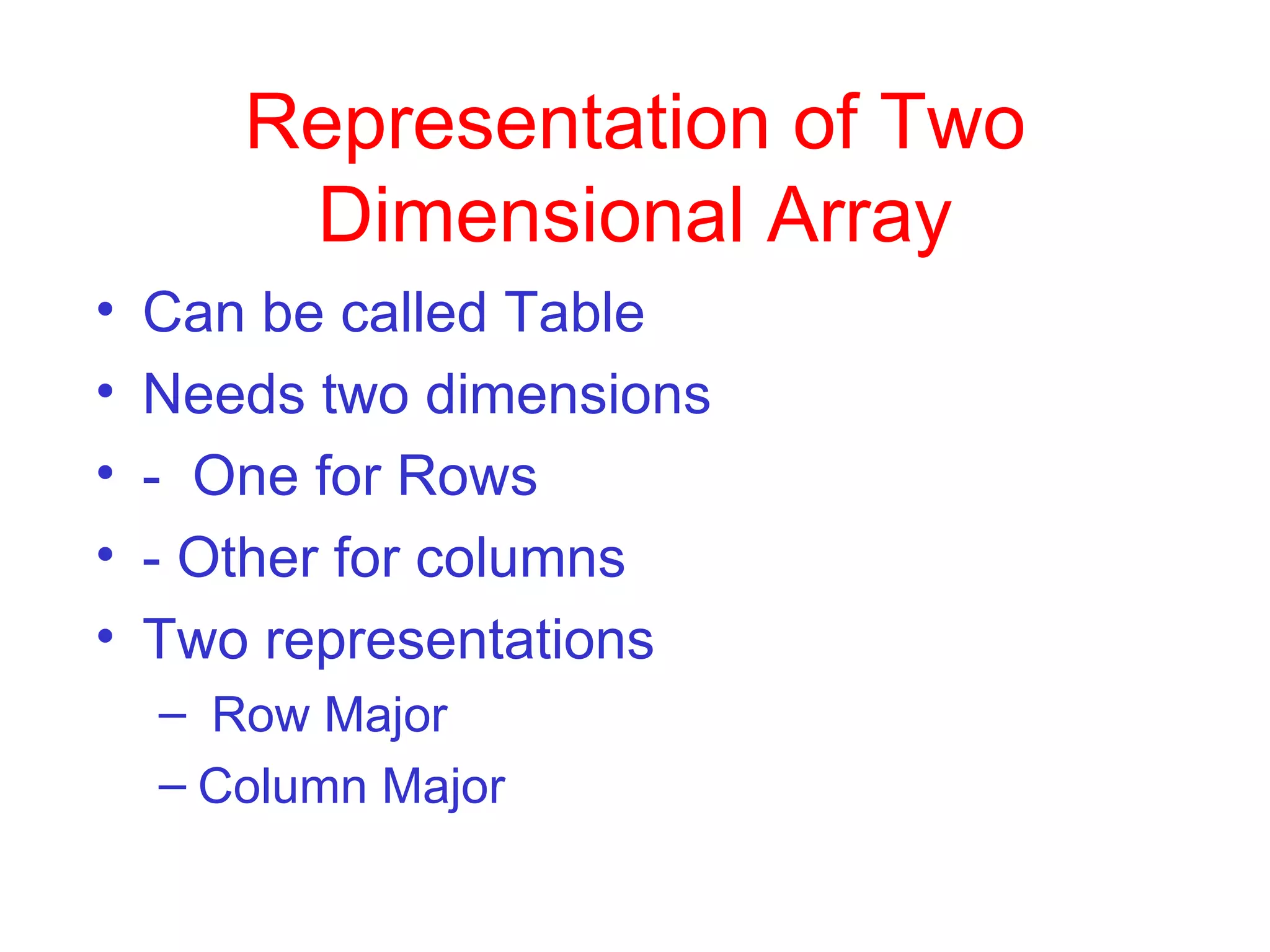
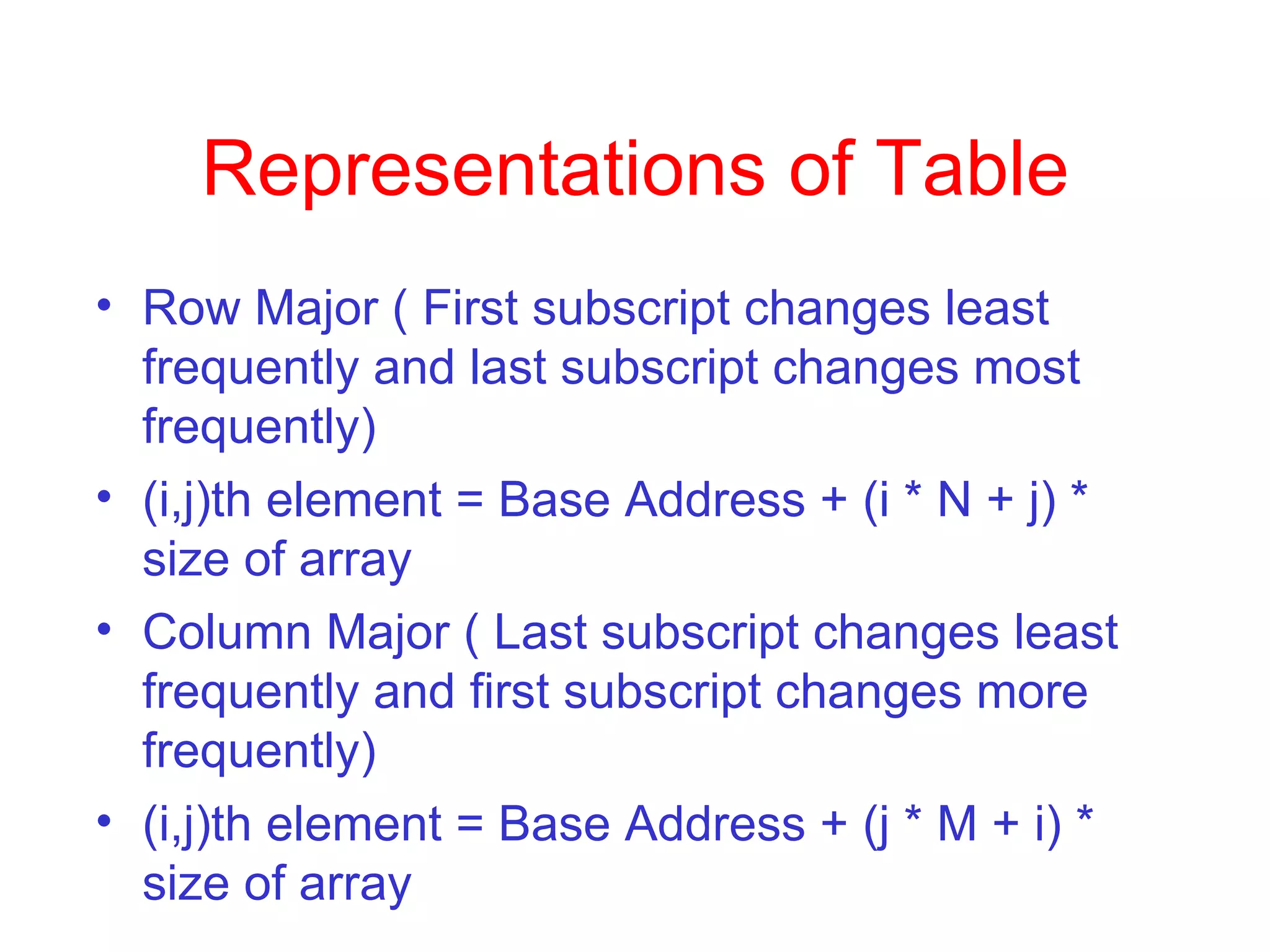
![void add (int a[][], int b[][], int c[][], int rows, int cols) { int i, j; for (i=0; i<rows; i++) for (j=0; j<cols; j++) c[i][j] = a[i][j] + b[i][j]; } What’s wrong?](https://image.slidesharecdn.com/02arraysandmemorymapping-090910110832-phpapp01/75/02-Arrays-And-Memory-Mapping-6-2048.jpg)
![const int N = 100; void add (int a[][N], int b[][N], int c[][N], int rows, int cols) { int i, j; for (i=0; i<rows; i++) for (j=0; j<cols; j++) c[i][j] = a[i][j] + b[i][j]; } Why?](https://image.slidesharecdn.com/02arraysandmemorymapping-090910110832-phpapp01/75/02-Arrays-And-Memory-Mapping-7-2048.jpg)
![Two Dimensional Array Offset of a[i][j]? 54 345 106 0 99 82 76 22 64 38 2 3 6 3 5 1 User’s view (abstraction) 54 345 106 0 99 82 76 22 64 38 2 3 6 3 5 1 System’s view (implementation)](https://image.slidesharecdn.com/02arraysandmemorymapping-090910110832-phpapp01/75/02-Arrays-And-Memory-Mapping-8-2048.jpg)
![Two Dimensional Array Offset of a[i][j]? Number of elements in each row? i th row total elements in the previous rows? j th element in i th row Offset (in units) N i * N i * N + j The addressing formula needs to know the number of columns but does not need the number of rows! 54 345 106 0 99 82 76 22 64 38 2 3 6 3 5 1 User’s view (abstraction)](https://image.slidesharecdn.com/02arraysandmemorymapping-090910110832-phpapp01/75/02-Arrays-And-Memory-Mapping-9-2048.jpg)
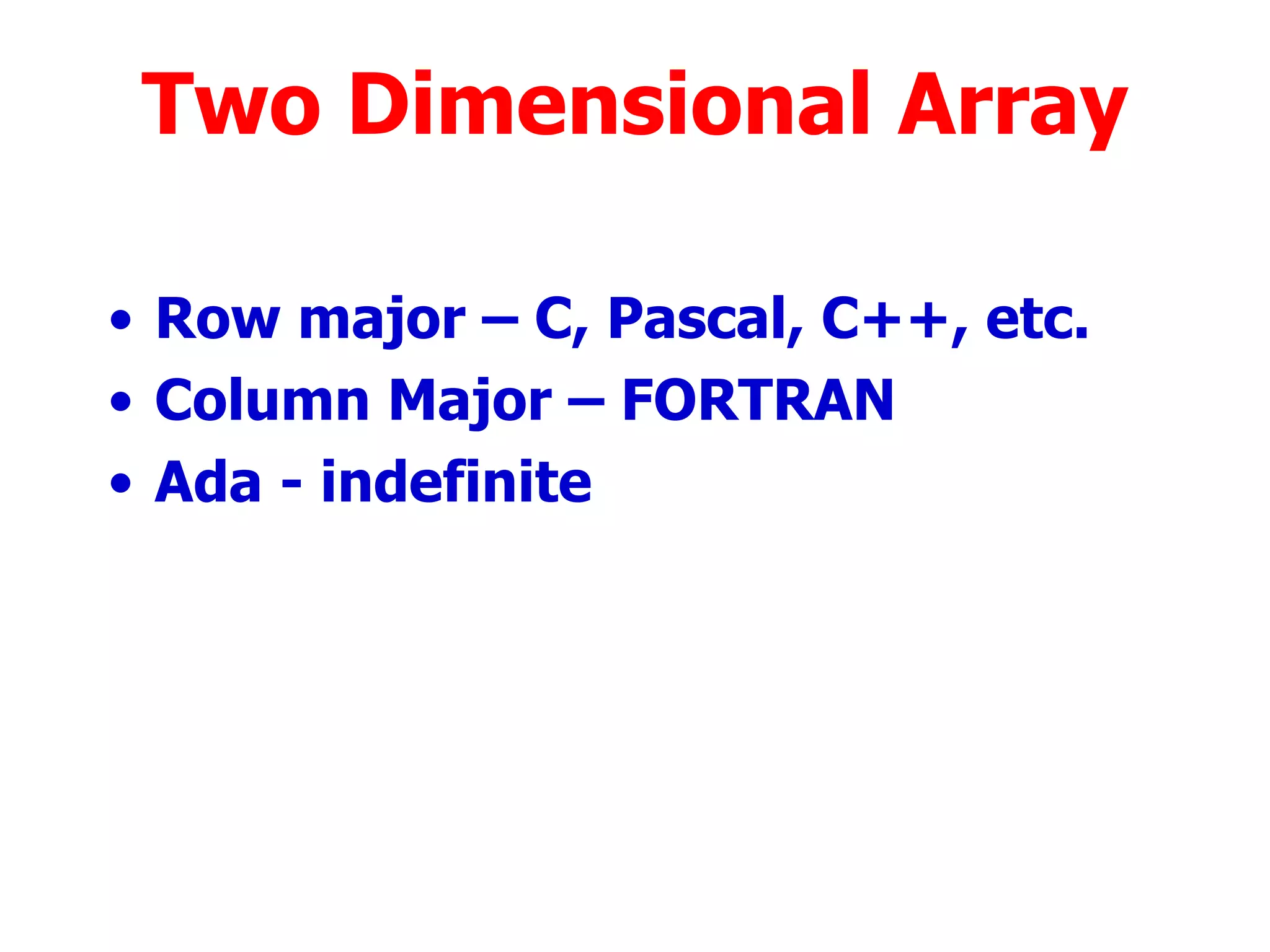
![Row Major Slice along the 1 st dimension to get an array of N-1 dimensions Continue until you are left with one dimension only. Offset of a[d 0 ] [d 1 ] …[d n-1 ] Multi-Dimensional Arrays A[D 0 ] [D 1 ]…[D n-1 ] (…((d 0 *D 1 + d 1 )*D 2 + d 2 )*D 3 + …) + d n-1](https://image.slidesharecdn.com/02arraysandmemorymapping-090910110832-phpapp01/75/02-Arrays-And-Memory-Mapping-11-2048.jpg)
![Simple View General formula in Row Major A[s1,s2,s3,...sn] = Base Address + ((s 1 * D 2 *D 3 *..D n ) + (s 2 * D 3 *D 4 *..D n ) + (s n-1 *D n ) + S n ) * Size of array General formula in Column Major A[s1,s2,s3,...sn] = Base Address + ((s n * D 1 *D 2 *..D n-1 ) + (s n-1 * D 1 *D 2 *..D n-2 ) + (s 2 *D 1 ) + S 1 ) * Size of array](https://image.slidesharecdn.com/02arraysandmemorymapping-090910110832-phpapp01/75/02-Arrays-And-Memory-Mapping-12-2048.jpg)
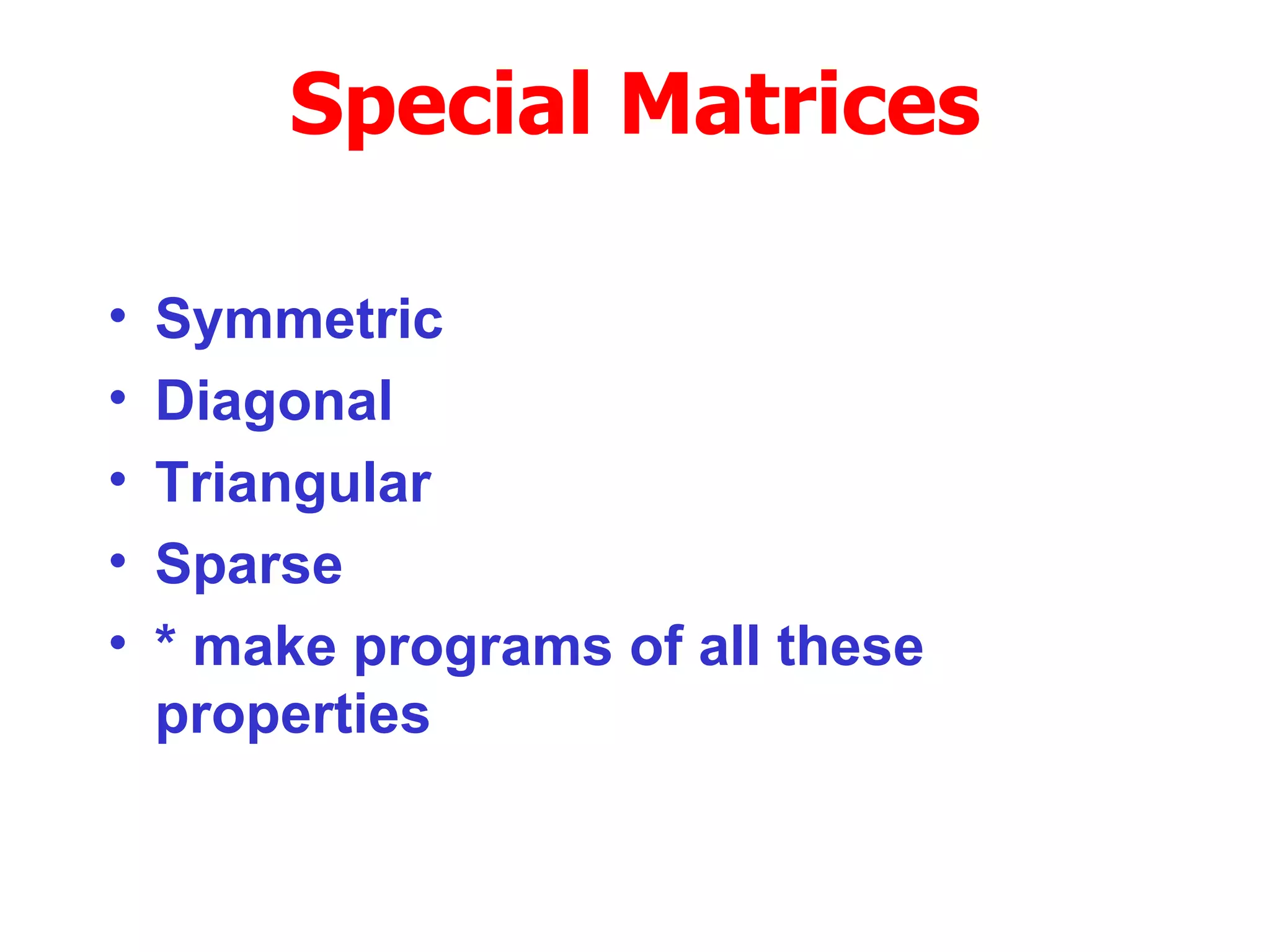
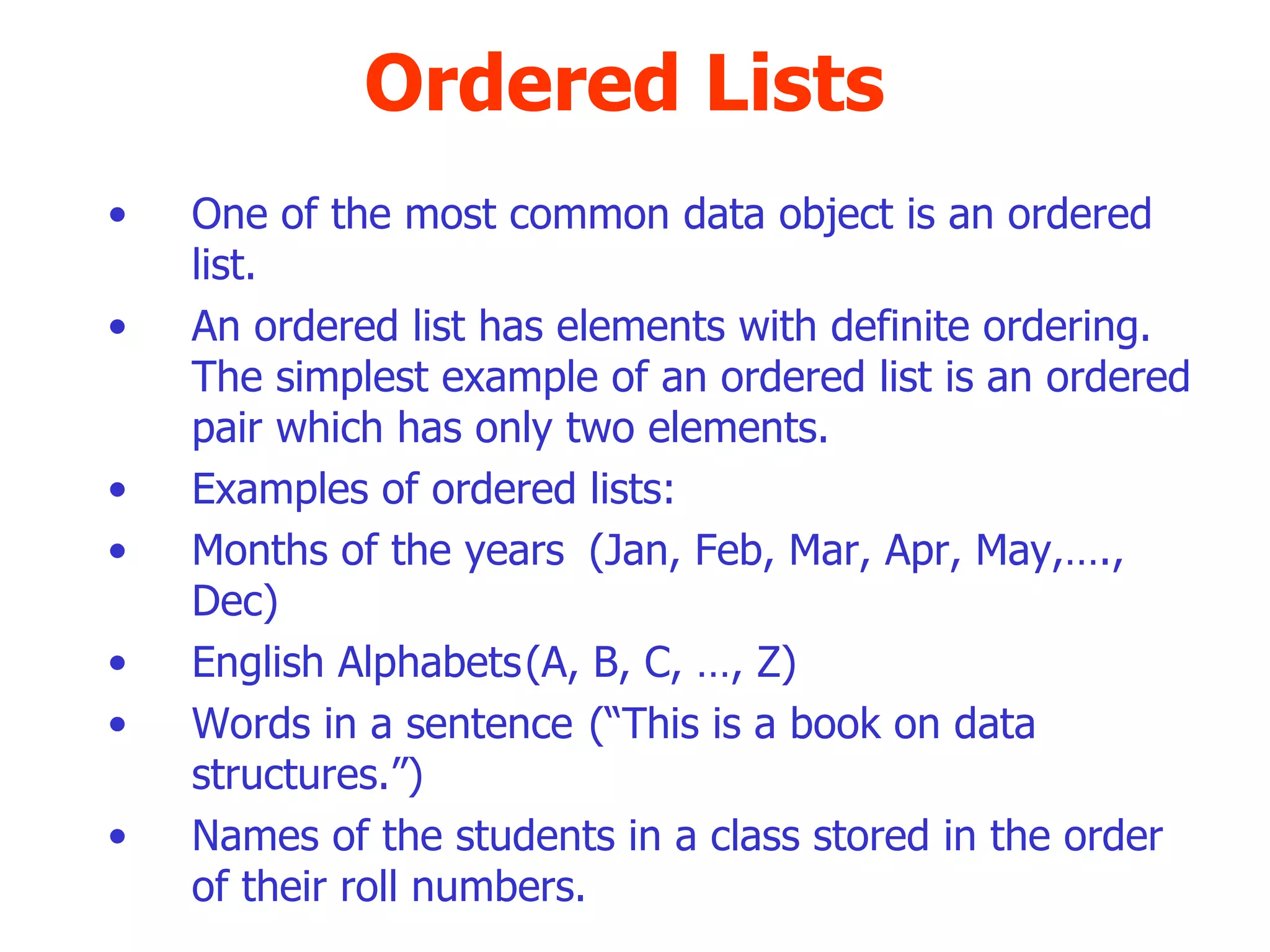
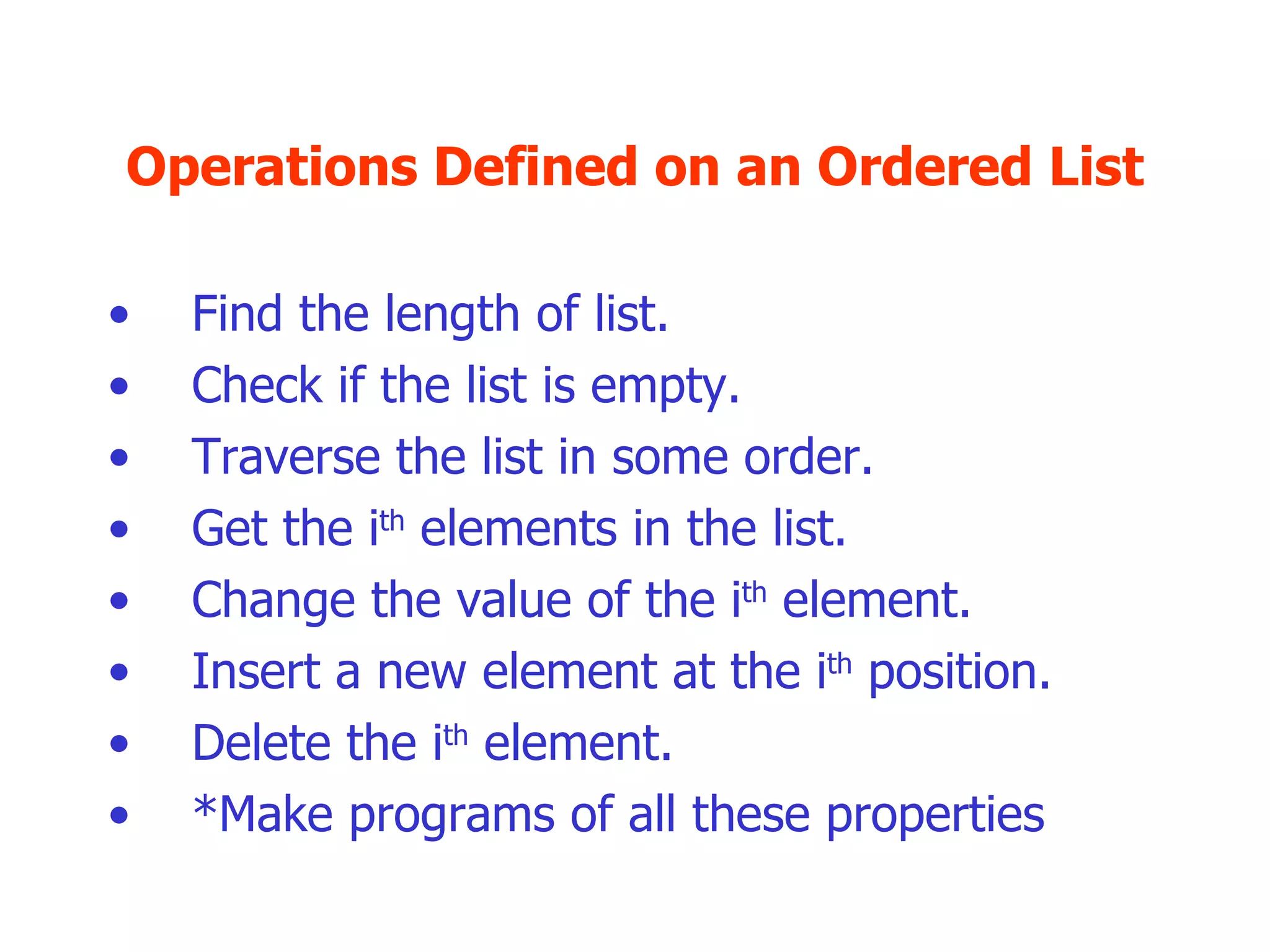
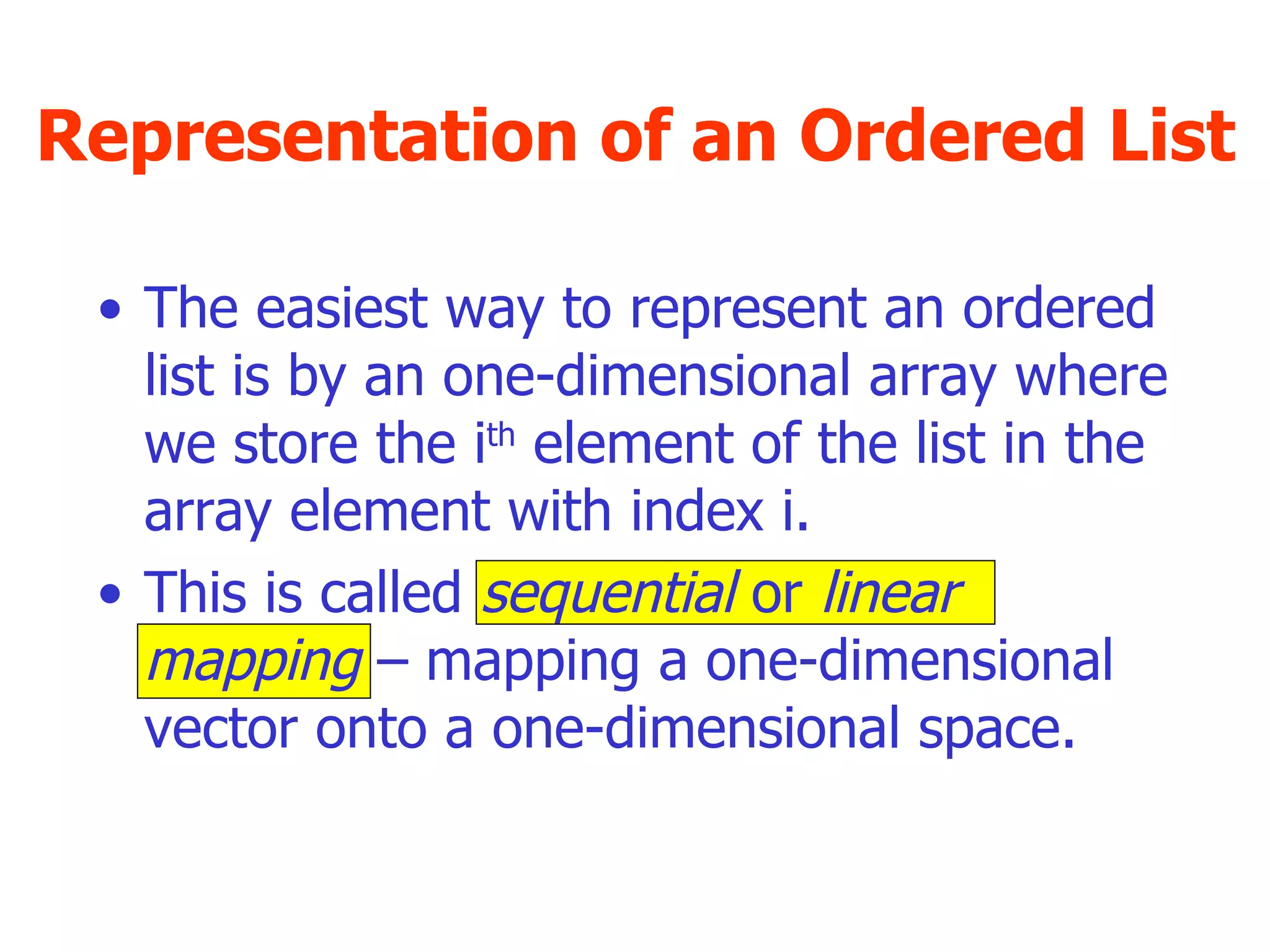
![class LinearList { public: LinearList(int s); // constructor ~ LinearList () {delete [ ] ListArray; } // destructor bool add (int value); bool remove (int index); bool change(int index, int value); bool get(int index, int & value); void printAll(); bool isFull() {return size == maxSize ;} bool isEmpty() {return size == 0; } int length() {return size;} private: int maxSize; // max List size int *ListArray; int size; // no. of elements in the List void readjust(int index); void moveForward(int index); void moveBackward(int index); }; Linear List Using Arrays](https://image.slidesharecdn.com/02arraysandmemorymapping-090910110832-phpapp01/75/02-Arrays-And-Memory-Mapping-17-2048.jpg)
![LinearList :: LinearList(int s) { maxSize = s; ListArray = new int[maxSize]; size = 0; } void LinearList :: printALL() { for (i = 0; i < size; i++) cout << ListArray[i] << newline; }](https://image.slidesharecdn.com/02arraysandmemorymapping-090910110832-phpapp01/75/02-Arrays-And-Memory-Mapping-18-2048.jpg)
![bool LinearList :: get(int index, int & value) { if (index < size && index >= 0) { value = ListArray[index]; return true; } else return false; }](https://image.slidesharecdn.com/02arraysandmemorymapping-090910110832-phpapp01/75/02-Arrays-And-Memory-Mapping-19-2048.jpg)
![bool LinearList::add(int value) { if (! isFull() ) { for (int i = size; i >= 1; i--) { if (ListArray[i-1] > value) ListArray[i] = ListArray[i -1]; else break; } ListArray[i] = value; size++; return true; } else return false; }](https://image.slidesharecdn.com/02arraysandmemorymapping-090910110832-phpapp01/75/02-Arrays-And-Memory-Mapping-20-2048.jpg)
![bool LinearList::remove(int index) { if (index < size && index >= 0) { for (int i = index; i < size - 1; i++) ListArray[i] = ListArray[i +1]; size--; return true; } else return false; }](https://image.slidesharecdn.com/02arraysandmemorymapping-090910110832-phpapp01/75/02-Arrays-And-Memory-Mapping-21-2048.jpg)
![bool LinearList :: change(int index, int value) { if (index < size && index >= 0) { ListArray[index] = value; readjust(index); return true; } else return false; } void LinearList :: readjust(int index) { if ((index < (size - 1)) && (ListArray[index] > ListArray[index + 1])) moveForward(index); else if ((index > 0) && (ListArray[index] < ListArray[index - 1])) moveBackward(index); }](https://image.slidesharecdn.com/02arraysandmemorymapping-090910110832-phpapp01/75/02-Arrays-And-Memory-Mapping-22-2048.jpg)
![void LinearList :: moveForward(int index) { int temp = ListArray[index]; int i = index; while ((i < (size - 1)) && (ListArray[i] > ListArray[i + 1])) { ListArray[i] = ListArray[i+1]; i = i + 1; } if (i != index) ListArray[i] = temp; } void LinearList :: moveBackward(int index) { int temp = ListArray[index]; int i = index; while ((i > 0 ) && (ListArray[i] < ListArray[i - 1])) { ListArray[i] = ListArray[i-1]; i = i - 1; } if (i != index) ListArray[i] = temp; }](https://image.slidesharecdn.com/02arraysandmemorymapping-090910110832-phpapp01/75/02-Arrays-And-Memory-Mapping-23-2048.jpg)
![Assignment# 1 last date of submission : 02-09-2008 (Tuesday) Obtain an addressing formula for elements a[i,j] in the upper triangular matrix of order nxn. You can assume that this upper triangular is stored row by row Arrays - Read a matrix , find upper triangular matrix, find diagonal matrix, find determinant of a matrix Strings - Read a string , find the length of string, a particular word, replace a particular word with new word. - Read an array of names of students and sort it. Structures - Make an array of structures (Roll-No, Name, Marks, Grade) , Display all records, find all the students with particular grade , find the record of a particular student, delete record of a particular student](https://image.slidesharecdn.com/02arraysandmemorymapping-090910110832-phpapp01/75/02-Arrays-And-Memory-Mapping-24-2048.jpg)